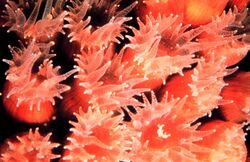Biology:Montastraea
| Great star coral | |
|---|---|

| |
| Scientific classification Error creating thumbnail: Unable to save thumbnail to destination
| |
| Domain: | Eukaryota |
| Kingdom: | Animalia |
| Phylum: | Cnidaria |
| Class: | Hexacorallia |
| Order: | Scleractinia |
| Family: | Montastraeidae Yabe & Sugiyama, 1941 |
| Genus: | Montastraea Blainville, 1830 |
| Species: | M. cavernosa
|
| Binomial name | |
| Montastraea cavernosa (Linnaeus, 1767)
| |
| Synonyms | |
|
List (Genus)
(Species)
| |
Montastraea is a genus of colonial stony coral found in the Caribbean seas. It is the only genus in the monotypic family Montastraeidae and contains a single species, Montastraea cavernosa, known as great star coral. It forms into massive boulders and sometimes develops into plates. Its polyps are the size of a human thumb and fully extend at night.[2]
Description
Great star coral colonies form massive boulders and domes over 5 feet (1.5 m) in diameter in waters of shallow and moderate depths. In deeper waters, this coral has been observed growing as a plate formation. It is found throughout most reef environments, and is the predominant coral at depths of 40–100 feet (12.2–30.5 m).
This coral occasionally has a fluorescent red or orange color during daytime; it has recently been suggested that this hue is due to phycoerythrin, a cyanobacterial protein. It appears that, in addition to symbiotic zooxanthella, this coral harbors endocellular symbiotic cyanobacteria, possibly to help it fix nitrogen. However more recently, Oswold et al. (2007) showed an absence of functional phycoerythrin in M. cavernosa.[3]
The species is gonochoric (colonies can be either male or female) and spawns one week after the full moon in late August. Skeletons show sex-related differences, with females having a less dense skeleton compared to males, which is presumably due to reallocating energy to egg production.[4]
Bleaching
The distinction of bleaching in reefs of M. cavernosa from merely white-coloured corals was shown to be difficult using standard reflectance techniques. A survey in the Bay of All Saints concluded that this may lead to nearly two-fold overestimation of bleaching.[5]
References
- ↑ Aronson, R.; Bruckner, A.; Moore, J.; Precht, B.; E. Weil. (2008). "Montastraea cavernosa". IUCN Red List of Threatened Species 2008: e.T133237A3646174. doi:10.2305/IUCN.UK.2008.RLTS.T133237A3646174.en. https://www.iucnredlist.org/species/133237/3646174. Retrieved 22 November 2022.
- ↑ "Common Corals of Florida". http://www.flmnh.ufl.edu/FISH/southflorida/coral/profiles.html#great.
- ↑ Oswald, Franz; Schmitt, Florian; Leutenegger, Alexandra; Ivanchenko, Sergey; D'Angelo, Cecilia; Salih, Anya; Maslakova, Svetlana; Bulina, Maria et al. (2007). "Contributions of host and symbiont pigments to the coloration of reef corals". FEBS Journal 274 (4): 1102–1122. doi:10.1111/j.1742-4658.2007.05661.x. PMID 17244197.
- ↑ "Sex-related differences in the sclerochronology of the reef-building coral Montastraea cavernosa: the effect of the growth strategy" (in en). Marine Biology 165 (2): 32. February 2018. doi:10.1007/s00227-018-3288-0. ISSN 0025-3162.
- ↑ Cruz, Igor C. S.; Leal, Miguel C.; Mendes, Carlos R.; Kikuchi, Ruy K. P.; Rosa, Rui; Soares, Amadeu M. V. M.; Serôdio, João; Calado, Ricardo et al. (April 2015). "White but not bleached: photophysiological evidence from white Montastraea cavernosa reveals potential overestimation of coral bleaching" (in en). Marine Biology 162 (4): 889–899. doi:10.1007/s00227-015-2633-9. ISSN 0025-3162.
Wikidata ☰ {{{from}}} entry
 |



